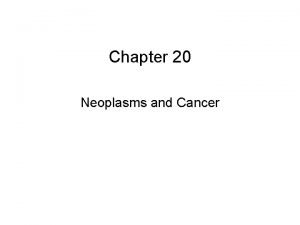Chapter 3 Neoplasms Copyright 2015 Cengage Learning Terminology

























- Slides: 25

Chapter 3 Neoplasms Copyright © 2015 Cengage Learning®.

Terminology Related to Neoplasms and Tumors • Neoplasm – New growth • Tumor – Swelling or neoplasm • Leukemia – Malignant disease of bone marrow • Hematoma – Bruise or contusion Copyright © 2015 Cengage Learning®.

Classification of Neoplasms • Cancer – General term for malignant tumor or neoplasm • Classified according to: – Appearance and growth pattern – Type of body tissue from which they arise Copyright © 2015 Cengage Learning®.

Classification of Neoplasms Copyright © 2015 Cengage Learning®.

Classification of Neoplasms Appearance & Growth Patterns • Benign – – Confined to local area Do not spread Commonly called tumors Usually harmless Copyright © 2015 Cengage Learning®.

Classification of Neoplasms Appearance & Growth Patterns • Malignant – Malignant means deadly – Spreads to other areas by • Invasion – spreading to surrounding tissue • Metastasis – spread to distant areas Copyright © 2015 Cengage Learning®.

Classification of Neoplasms Tissue of Origin • Benign – Tissue + oma ex. lipoma • Malignant – – Carcinoma – epithelial or skin tissue Sarcoma – connective tissue (bone, muscle, fat) Lymphoma – lymphatic & blood Other – brain Copyright © 2015 Cengage Learning®.

Benign and Malignant Neoplasm Growth • Benign tumors – Growth in particular area • But not invasive or metastatic – Encapsulated in capsule – Easier to excise – Limited growth potential • Malignant tumors – – Excessive, without regulation Without structure or function of normal cells Surface area not encapsulated Fast growing, outpace normal cells Copyright © 2015 Cengage Learning®.

Hyperplasias and Neoplasms • Similarities: – Mean overgrowth of cells • Causing increase in size of tissue – Produce masses identified as hyperplasia or neoplasm • Differences: – Cause – Extent of growth Copyright © 2015 Cengage Learning®.

Development of Malignant Neoplasm • Genetic mutation due to: – Radiation – Viruses – Carcinogens • Cancer-causing agents – Chemicals Copyright © 2015 Cengage Learning®.

Development of Malignant Neoplasm • Carcinoma in situ – Atypical cells in epithelial layer of tissue • Have not invaded surrounding tissue • Invasion of precancerous cells – Final stage of cancer development Copyright © 2015 Cengage Learning®.

Invasion and Metastasis of Cancer • Carcinomas and epithelial tissue neoplasms commonly spread • Lymph nodes filter cancer cells • Absence of lymph node involvement favorable – Making surgical cure possible • Sarcomas shed cells into bloodstream Copyright © 2015 Cengage Learning®.

Grading and Staging of Cancer • Grading – Determines degree of abnormality • Staging – Considers degree of spread Copyright © 2015 Cengage Learning®.

Causes of Cancer • For many cancers, cause is unknown • Carcinogenesis progresses slowly – May start, stop, or be reversed but usually is a continual progression • Prevention and cure frequently depend on finding initiating agents Copyright © 2015 Cengage Learning®.

Causes of Cancer • • • Chemical carcinogens Hormones Radiation Viruses Genetic predisposition Copyright © 2015 Cengage Learning®.

Causes of Cancer • Personal risk behaviors – Diet – Sexual behavior – Alcohol use Copyright © 2015 Cengage Learning®.

Cancer Prevention • Preventive measures: – – – – – Do not smoke Limit alcohol intake Protect skin from excessive sun exposure Refuse needless x-rays Avoid heavily polluted air Follow labels when using pesticides and chemicals Maintain healthy body weight Regular breast self-exams (women) Exercise regularly Copyright © 2015 Cengage Learning®.

Cancer Prevention • Preventive measures (continued) – Routine HPV vaccination for girls and boys – Regular checkups by a physician • • Clinical breast examination for females Papanicolaou (Pap) smears for females Prostate examinations for males Rectal examinations for males and females Copyright © 2015 Cengage Learning®.

Frequency of Cancer • A leading cause of death in United States • Affects one in two males and one in three females • Affects people of all ages – Both male and female • Most common: – Basal and squamous cell skin cancer Copyright © 2015 Cengage Learning®.

Frequency of Cancer • Most common (excluding skin cancer): – Lung – Colon/Rectum – Breast – Prostate Copyright © 2015 Cengage Learning®.

Diagnosis of Cancer Warning Signs • Change in bowel or bladder habits • • • A sore that does not heal Unusual bleeding or discharge Thickening lump in breast or elsewhere Indigestion or difficulty swallowing Obvious change in a wart or mole Nagging cough or hoarseness Copyright © 2015 Cengage Learning®.

Diagnosis of Cancer • Prognosis best if treated early • Routine screening is helpful • May be found accidentally • Once discovered, biopsy recommended Copyright © 2015 Cengage Learning®.

Signs and Symptoms of Cancer • • Pain Obstruction Hemorrhage Anemia Fracture Infection Cachexia Copyright © 2015 Cengage Learning®.

Treatment • Options: – Palliative • Prevent pain and discomfort – But does not seek to cure disease – Preventive • Prevent disease from starting Copyright © 2015 Cengage Learning®.

Cancer Treatment • Surgery • Chemotherapy • Radiation • Hormone Therapy Copyright © 2015 Cengage Learning®.
 Peripheral giant cell granuloma
Peripheral giant cell granuloma Copyright cengage learning. powered by cognero
Copyright cengage learning. powered by cognero 2009 delmar cengage learning
2009 delmar cengage learning Alges root word
Alges root word Cengage medical terminology chapter 1
Cengage medical terminology chapter 1 Chapter 6:2 interpreting word parts
Chapter 6:2 interpreting word parts Chapter 13 medical math assignment sheet
Chapter 13 medical math assignment sheet Chapter 7:10 respitory system
Chapter 7:10 respitory system Copyright 2015 all rights reserved
Copyright 2015 all rights reserved Copyright 2015 all rights reserved
Copyright 2015 all rights reserved Cengage learning heart diagram
Cengage learning heart diagram Cengage learning heart diagram
Cengage learning heart diagram South-western cengage learning
South-western cengage learning 2009 delmar cengage learning
2009 delmar cengage learning Cengage learning heart diagram
Cengage learning heart diagram Delmar learning medical abbreviations
Delmar learning medical abbreviations Cengage learning australia
Cengage learning australia Graphing tpr
Graphing tpr Cengage learning
Cengage learning Cengage learning
Cengage learning Wadsworth cengage learning
Wadsworth cengage learning Cengage learning
Cengage learning Cengage learning plant cell
Cengage learning plant cell Cengage learning
Cengage learning Cengage learning
Cengage learning Brooks cole cengage learning
Brooks cole cengage learning















































